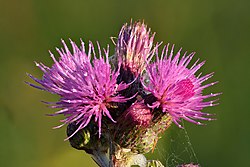| Cirsium palustre | |
|---|---|
 | |
| Scientific classification | |
| Kingdom: | Plantae |
| Clade: | Tracheophytes |
| Clade: | Angiosperms |
| Clade: | Eudicots |
| Clade: | Asterids |
| Order: | Asterales |
| Family: | Asteraceae |
| Genus: | Cirsium |
| Species: | C. palustre |
| Binomial name | |
| Cirsium palustre (L.) Scop. | |
| Synonyms [1] | |
Selected synonyms
| |
Cirsium palustre, the marsh thistle [2] or European swamp thistle, is a herbaceous biennial (or often perennial) flowering plant in the family Asteraceae. [3] [4]
